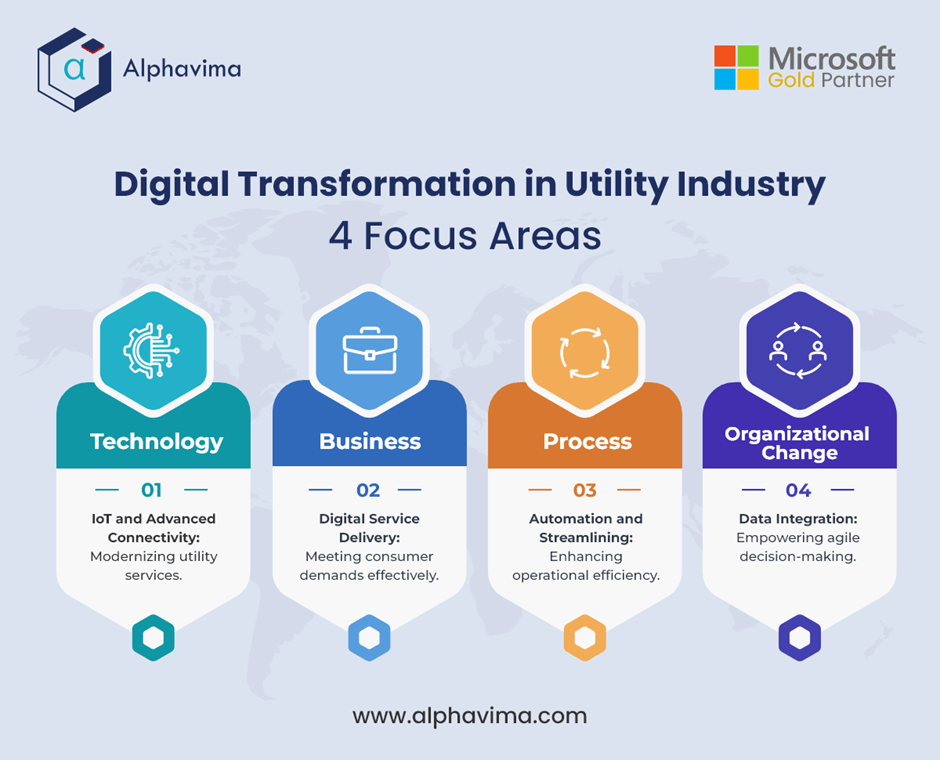Technology adoption and digital transformation in the utility industry not only enhance operational efficiency but also help meet sustainability goals and improve customer service.
Utilities need to continue exploring and integrating new technologies to address the evolving challenges and opportunities in the sector. Replacing outdated technology with cutting-edge advancements allows utility companies to innovate extensively and rapidly, creating value in collaboration with their ecosystem partners.
What Is Digital Transformation in Utilities?
Digital transformation isn’t simply about adding new technology to existing processes. Successful digital transformation requires efficient ways of working across four focus areas and a commitment to transformation.
> Technology: Advanced communications and network connectivity technologies make up any digital transformation. With IoT, power utilities are modernizing.
> Business: To meet consumer demand for how services get delivered, determine how and what services to deliver digitally.
> Process: Use digital technologies to automate or streamline business processes. This might include anything from automating alerts to using a centralized digital platform to track and manage smart devices across facilities.
> Organizational Change: Create greater worker agility by integrating data and analytics across the organization.

Why Utilities Are Moving Toward Data and the Cloud
Every industry is going through digital transformation and the energy and utility market is no exception. These companies need to adopt various digital changes in their business models and processes to transform the way energy is produced, delivered, and consumed across the value chain. Businesses can enhance operational performance, make better business decisions, and improve the customer experience by successfully leveraging data and providing more accurate information via predictive analytics.
Why Energy and Utility Analytics Are Key to Digital Transformation
The global energy and utility analytics market is projected to reach $6.55 billion by 2028, reflecting a growing demand for data-driven decision-making in the sector (Source: Emergen Research). As energy companies seek to cut costs, boost efficiency, and meet evolving customer expectations, analytics solutions have become vital for sustainable digital transformation.
One major driver of this trend is the widespread adoption of smart meters, coupled with the need for accurate energy forecasting and efficient power generation planning. ERP platforms like Olix365 act as accelerators helping utilities gain deep insights into customer behavior, improve system performance, and make strategic, data-backed decisions. With analytics in place, energy providers can personalize programs to maximize customer engagement while building long-term loyalty.
Another area seeing significant benefit is renewable energy. According to Mordor Intelligence, solar energy is expected to outpace both wind and hydro in electricity generation over the next four years. Using energy and utility analytics, providers can better plan energy generation, optimize asset performance, and ensure regulatory compliance through real-time insights and forecasting tools.
In short, energy and utility analytics are no longer optional-they are essential tools for utilities aiming to modernize operations, empower leadership, and deliver reliable, data-enabled services in a fast-changing market.
The Growth of Cloud-Based Analytics Solutions
Cloud-based solutions and data-driven analytic systems are also becoming essential for managing the vast amounts of data continuously generated by smart meters, IoT sensors, customer home energy devices, etc. It helps simplify energy efficiency programs and allows utilities to provide flexible power, provide scalability, ease equipment maintenance, and provide better customer service.
Embracing a New Digital Mindset in the Utilities Industry
To achieve true digital transformation in utilities, energy providers must rethink their leadership approach and embrace a forward-looking mindset. In Europe and North America, several major utilities are already leading the charge in renewables and grid modernization. As the electric grid-the world’s most complex machine-becomes more flexible and resilient, the integration of digital assets, processes, and technologies is accelerating at an unprecedented pace.
This transformation demands bold leadership. Utilities must address legacy challenges and capitalize on emerging opportunities by adopting innovative thinking. Industry leaders can draw from lessons learned during extreme weather events and infrastructure strain to guide a new era of digital innovation, centered on agility, data, and sustainability.
Traditional methods are no longer effective in managing today’s energy mix, evolving customer expectations, and distributed grid models. A modern approach is essential-one that enables sustainable, reliable, and affordable power delivery. Utility companies must balance service reliability with the need to deliver new offerings faster, support the energy transition, and lead with confidence.
Ultimately, digital transformation in utilities isn’t just about adopting technology-it’s about shifting culture. The sector is undergoing significant disruption, and while the pace of change can seem daunting, it also reveals the art of the possible. Those utilities that embrace change, champion innovation, and act decisively will shape the future of energy.
Technology Integration with Industry Accelerators
A key enabler of digital transformation in the utilities sector is the strategic use of industry accelerators that provide ready-to-use tools functionality tailored to sector-specific workflows.
One such accelerator, Olix365, enhances utility operations by streamlining data flow, enabling real-time analytics, and improving decision-making processes – all within a Microsoft-powered ecosystem.
Technology Stack Behind Olix365
> Built on Microsoft Dynamics 365
> Integrates with Azure Data Lake, Power Platform, and Dataverse
> Supports automation with Power Automate and low-code customization via Power Apps
> Security and scalability driven by Microsoft Azure Infrastructure
These technologies work in tandem to create a platform that’s agile, scalable, and deeply aligned with operational demands of the utilities and energy sector.
Utility & Energy Accelerator: Real Impact in Action
Alphavima’s deep domain experience in the energy and utilities industry is reflected in solutions like Olix365, our cloud-based accelerator purpose-built for utility operations. From regulatory reporting to preventive maintenance, and from asset lifecycle management to customer service, Olix365 helps utilities modernize with confidence.
Conclusion
By eliminating legacy systems and taking a data-driven, cloud-enabled approach, energy and utility companies can reduce operating costs and increase efficiency. Big data and analytics also enable them to provide customers with better services and design programs to save more energy – thus ensuring customer loyalty.
Initiate Change by Connecting with Our Technology Expert Today!



